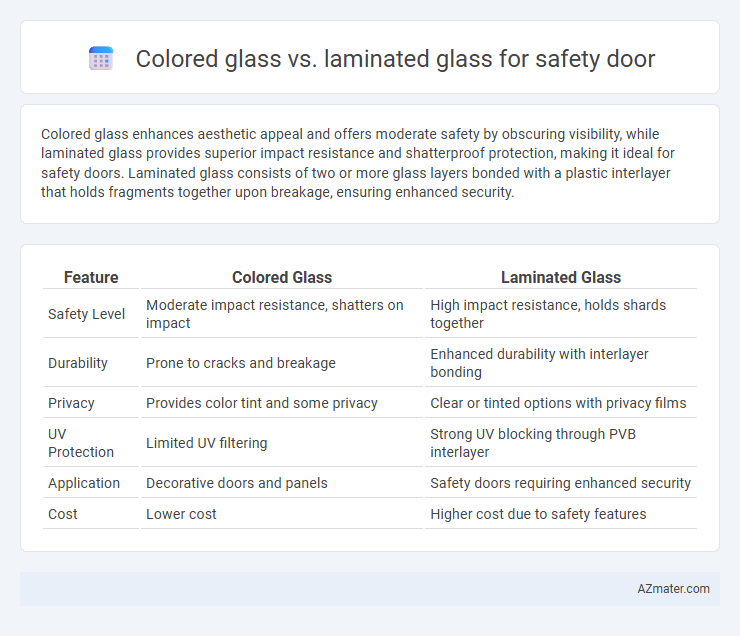Colored glass enhances aesthetic appeal and offers moderate safety by obscuring visibility, while laminated glass provides superior impact resistance and shatterproof protection, making it ideal for safety doors. Laminated glass consists of two or more glass layers bonded with a plastic interlayer that holds fragments together upon breakage, ensuring enhanced security.
Table of Comparison
| Feature | Colored Glass | Laminated Glass |
|---|---|---|
| Safety Level | Moderate impact resistance, shatters on impact | High impact resistance, holds shards together |
| Durability | Prone to cracks and breakage | Enhanced durability with interlayer bonding |
| Privacy | Provides color tint and some privacy | Clear or tinted options with privacy films |
| UV Protection | Limited UV filtering | Strong UV blocking through PVB interlayer |
| Application | Decorative doors and panels | Safety doors requiring enhanced security |
| Cost | Lower cost | Higher cost due to safety features |
Introduction to Safety Door Glass Options
Colored glass enhances safety door aesthetics by incorporating tinted or frosted hues that increase privacy while maintaining strength. Laminated glass consists of multiple glass layers bonded with a plastic interlayer, providing superior impact resistance and preventing shattering upon breakage. Selecting between colored and laminated glass depends on balancing design preferences with critical safety requirements for secure, durable door installations.
What is Colored Glass?
Colored glass is glass that contains added metal oxides or pigments during its manufacturing process, resulting in a variety of vibrant hues for decorative and functional purposes. In safety door applications, colored glass enhances aesthetic appeal while maintaining strength and transparency, making it a popular choice for both residential and commercial settings. Unlike laminated glass, which is layered with interlayers for impact resistance, colored glass emphasizes design versatility without compromising essential safety features.
What is Laminated Glass?
Laminated glass consists of two or more glass layers bonded together with an interlayer, typically made of polyvinyl butyral (PVB), enhancing its strength and safety properties. It is designed to hold shards in place when broken, reducing the risk of injury and providing reliable security for safety doors. Compared to colored glass, laminated glass offers superior impact resistance and durability, making it a preferred choice for safety applications.
Safety Performance: Colored vs Laminated Glass
Laminated glass offers superior safety performance for safety doors due to its multiple layers that hold shards together upon impact, reducing injury risk compared to colored glass, which primarily serves aesthetic purposes without added safety benefits. Colored glass lacks the strength and fracture resilience of laminated glass, making it less effective in preventing penetration or maintaining structural integrity during breakage. For maximum protection in safety doors, laminated glass is the preferred choice due to its enhanced impact resistance and ability to stay intact under stress.
Impact Resistance Comparison
Colored glass typically offers moderate impact resistance, suitable for decorative safety doors but less effective under high-stress conditions. Laminated glass, composed of multiple layers bonded with polyvinyl butyral (PVB), provides superior impact resistance by holding shards together upon breakage, significantly enhancing safety. For safety doors requiring maximum protection against impacts, laminated glass is generally the preferred choice due to its enhanced durability and shatterproof properties.
Security Benefits of Each Glass Type
Colored glass enhances security in safety doors by obscuring visibility, preventing potential intruders from easily assessing the interior, while its tempered structure offers strong resistance against impact and forced entry. Laminated glass improves security through its multiple bonded layers that hold shattered pieces together upon breakage, reducing the risk of injury and delaying forced entry attempts. Both glass types provide distinct safety advantages: colored glass adds privacy and impact resistance, whereas laminated glass prioritizes shatter containment and prolonged intrusion prevention.
Aesthetic and Design Considerations
Colored glass offers a vibrant, customizable aesthetic with a wide range of hues and translucency levels that enhance modern safety door designs, creating a striking visual impact while maintaining privacy. Laminated glass provides versatility in design by allowing decorative interlayers, such as patterned or tinted films, which contribute to both safety and an elegant appearance. Both materials are ideal for safety doors, with colored glass excelling in bold color statements and laminated glass offering layered textures and subtle design options.
Cost Comparison: Colored vs Laminated Glass
Colored glass typically costs less than laminated glass due to simpler manufacturing processes and fewer layers involved. Laminated glass, composed of multiple glass sheets bonded with an interlayer, offers superior safety benefits but comes with higher material and production expenses. Choosing colored glass for safety doors can reduce initial costs, while laminated glass incurs greater investment with enhanced impact resistance and security.
Maintenance and Durability Factors
Colored glass offers a vibrant aesthetic for safety doors but may require more frequent cleaning to prevent discoloration and surface degradation from UV exposure. Laminated glass enhances durability by incorporating an interlayer that holds glass shards together upon impact, reducing the risk of breakage and maintaining structural integrity over time. Both materials demand routine inspections, but laminated glass typically offers superior long-term resilience and lower maintenance needs in safety-critical applications.
Which Glass Type is Best for Your Safety Door?
Colored glass enhances aesthetic appeal and offers moderate impact resistance, making it suitable for decorative safety doors in low-risk areas. Laminated glass consists of multiple layers with a polyvinyl butyral (PVB) interlayer that holds shards together upon impact, providing superior strength, shatter resistance, and enhanced security features. For maximum safety and durability in safety doors, laminated glass is the best choice due to its reliable protection against breakage and forced entry.

Infographic: Colored glass vs Laminated glass for Safety door
 azmater.com
azmater.com